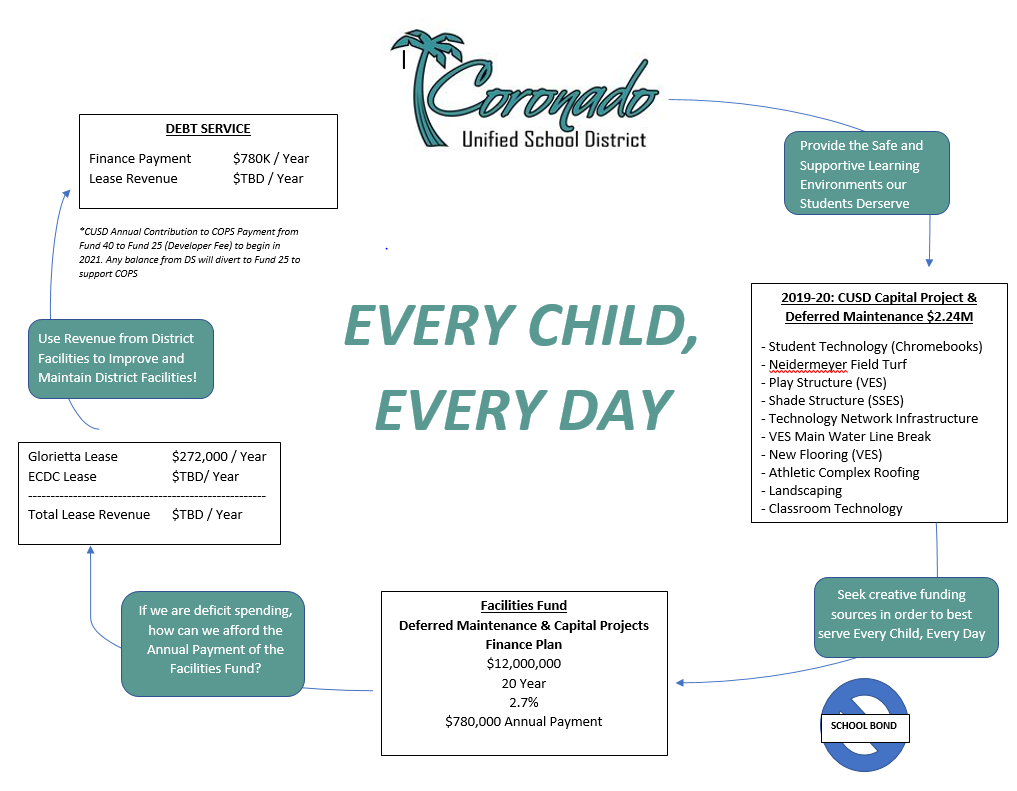2.0 Budget
Present the Governing Board with a structurally-balanced budget that includes a planned spend-down of reserve funds and minimizes impacts to programs while maximizing student achievement and learning.
2.1 Create a plan which demonstrates a fiscally solvent budget spend-down in anticipation of reaching ‘Basic Aid’ status with viable reserves while prioritizing student access to programs, resources, and curricula aligned with CUSD Mission Statement.
2.5 Deliberately seek out creative funding sources in order to best serve Every Child, Every Day across CUSD.
Due to the structure of the Local Control Funding Formula calculation, Coronado Unified School District receives approximately $1,500 less per pupil than our neighboring districts. Until we reach Basic Aid status, our local property taxes will not and do not fund our public schools. Sacramento allocates resources for education through the Department of Finance based off of a formula tied directly to state revenue. One impact of the current pandemic is significant loss of revenue across California. The uncertainty of stable and adequate funding for the school year 2020-21 compounds our local woes. We do not believe pursuing a community bond or tax is prudent or appropriate. In addition to health and safety concerns, our community is also feeling the financial insecurity directly tied to COVID-19 related closures.
It is incumbent upon us to be proactive in order to mitigate uncertainty by securing necessary resources in order to continue meeting the needs of our students.
Annually, CUSD expends approximately $2.0 million on technology and facilities; specifically capital projects and deferred maintenance. These resources are diverted from our reserves or our general fund. By securing $12 million in funding through financing, we will create an alternative funding source to be used exclusively for these expenditures. These funds will be legally restricted and designated solely for capital projects and deferred maintenance. In doing so, we will significantly decrease the spend-down of general fund reserves while minimizing impacts to essential staffing and programs for our students.
If approved, our finance proposal includes a funding source for loan payments; revenues generated from lease agreements on two district properties. Our existing lease agreement for the Glorietta property and pending lease agreement for designated space at the Early Childhood Development Center (ECDC) will be allocated exclusively for repayment of our finance agreement.
In essence, we are leveraging non-instructional district facilities (via lease payments) to support and maintain instructional facilities (capital projects and deferred maintenance). A simplified graphic illustrates our proposed course of action.
This initiative is directly tied to our Long Range Plan.

4.0 Communication
4.1 One School, One Campus Update
In March, 2019, the Governing Board approved the relocation of Transitional Kindergarten and Kindergarten students back to the main campus at Village Elementary School, effective school year 2020-21. Action taken by the Governing Board included direction for the Superintendent to provide monthly updates and timelines on efforts made to adequately prepare the facilities, staff, students, and community for the transition.
The decision to integrate our Transitional Kindergarten and Kindergarten students was predicated on five initiatives; to increase safety and support, to maximize instructional programs and staff collaboration, to centralize resources and services, and to provide budget and operational efficiencies.
Operating a separate facility exclusively for our TK/K program necessitated additional certificated and classified staffing. Returning to one campus provided an opportunity to identify and redirect redundancies in staff. These staffing adjustments are ongoing efficiencies and provide relief to our budget.

One-time expenditures arise from non-operational purposes.These expenses are non-recurring in nature and therefore not considered part of an organization's ongoing business operations and budget. The costs associated with the relocation of our TK/K students to Village Main fall into this category.

The outcome of staffing redundancies and efficiencies to our budget immediately offsets the one-time expenditures. This trend will continue in out-years. Another component of this One School, One Campus initiative, as outlined above, includes leveraging our ECDC classroom facilities to generate ongoing lease revenue. This additional revenue, combined with staffing efficiencies, significantly supports staff effort to reduce our budget deficit. This action is in alignment with guiding principles outlined in our Long Range Plan: We will adhere to our fiduciary responsibility for budget stability and in order to sustain programs and supports which enrich students’ experiences.